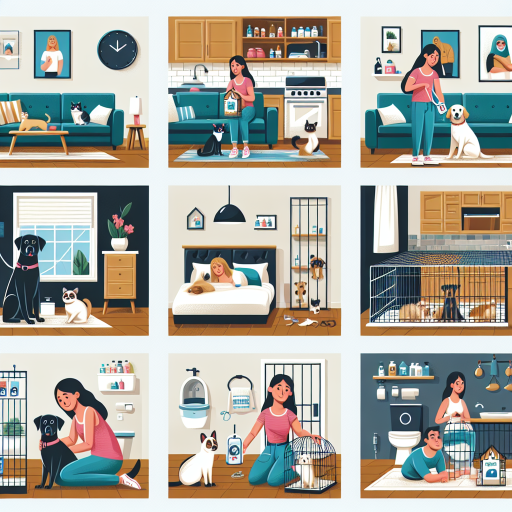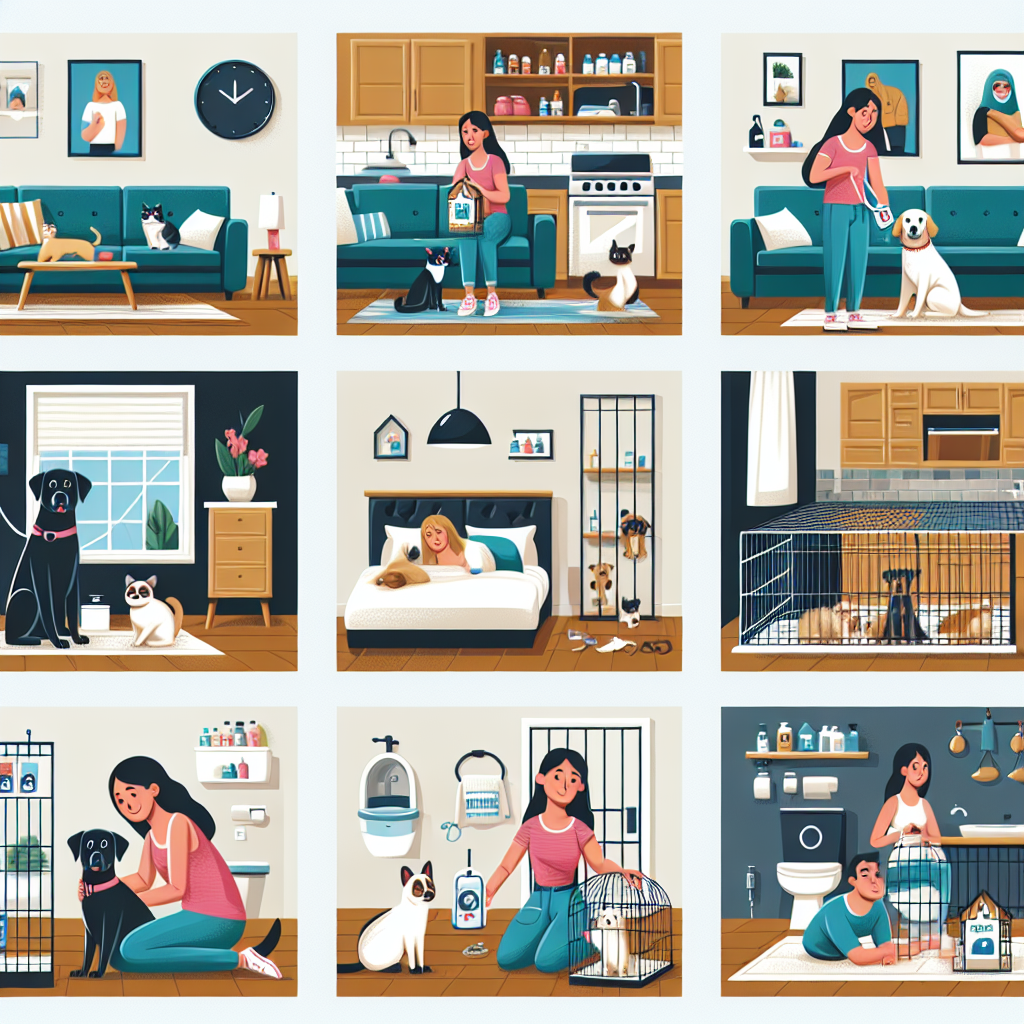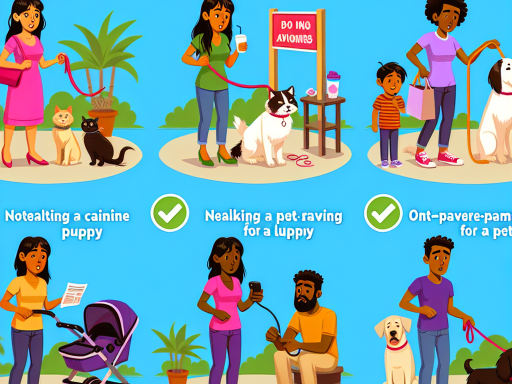Introduction
Hey there pet parents! Whether you have a fluffy feline friend or a playful pup, one thing is for sure – their safety is our top priority. As much as we love our pets and want them to roam freely around our homes, it’s crucial to create a pet-safe environment to prevent any accidents or mishaps. From securing hazardous items to providing clear instructions for pet-sitters, there are a few key steps you can take to ensure your furry companions are happy, healthy, and out of harm’s way.
In this guide, we will walk you through some essential tips on how to pet-proof your home and keep your beloved pets safe and sound. So grab a cup of tea, cuddle up with your furry friend, and let’s dive into creating a safe and secure space for your pets!
Now, let’s get started on making your home a pet-friendly paradise! 🐾
“`html
Introduction
Hey there pet parents! Whether you have a fluffy feline friend or a playful pup, one thing is for sure – their safety is our top priority. As much as we love our pets and want them to roam freely around our homes, it’s crucial to create a pet-safe environment to prevent any accidents or mishaps. From securing hazardous items to providing clear instructions for pet-sitters, there are a few key steps you can take to ensure your furry companions are happy, healthy, and out of harm’s way.
In this guide, we will walk you through some essential tips on how to pet-proof your home and keep your beloved pets safe and sound. So grab a cup of tea, cuddle up with your furry friend, and let’s dive into creating a safe and secure space for your pets!
Now, let’s get started on making your home a pet-friendly paradise! 🐾
“`
Pets are curious creatures by nature, always exploring and getting into mischief. As pet owners, it’s our responsibility to ensure that our homes are safe and pet-proofed to prevent any accidents or injuries. So, let’s dive into some tips on how to pet-proof your home and keep your furry friends out of harm’s way.
**Pet-Proof Your Home**
1. **Secure Loose Wires and Cords**: Pets love to chew on things, and electrical wires are no exception. To prevent any potential electric shocks or fires, make sure to secure all loose wires and cords out of your pet’s reach. You can use cable management solutions or hide them behind furniture.
2. **Keep Toxic Plants Out of Reach**: Many common household plants are toxic to pets if ingested. To keep your furry friends safe, make sure to research which plants are harmful and either remove them from your home or place them in a location that your pets can’t access.
3. **Store Cleaning Products Safely**: Cleaning products contain toxic chemicals that can be harmful to pets if ingested. Make sure to store all cleaning products in a secure cabinet or high shelf where your pets can’t reach them. Consider using pet-friendly cleaning products to minimize any risks.
4. **Close Toilet Lids**: Pets are naturally curious and may try to drink from the toilet bowl, which can be dangerous due to the chemicals in cleaning products. Keep toilet lids closed to prevent any accidents.
5. **Block Off Dangerous Areas**: If there are areas in your home that are off-limits to pets, make sure to block them off with baby gates or barriers. This can include rooms with fragile items, hazardous materials, or areas where your pet could get stuck.
By following these simple tips, you can create a safe environment for your pets to roam freely without the risk of harm. Remember, prevention is key when it comes to pet-proofing your home. Stay one step ahead by anticipating any potential dangers and taking proactive measures to keep your furry friends safe and happy.
“`
Pet-Proof Your Home
- Secure Loose Wires and Cords
- Keep Toxic Plants Out of Reach
- Store Cleaning Products Safely
- Close Toilet Lids
- Block Off Dangerous Areas
“`
Create Safe Spaces for Your Pets
When it comes to keeping your furry friends safe and comfortable, providing them with designated safe spaces within your home is key. Whether you have a playful puppy or a curious cat, having a designated area for them to retreat to can help prevent accidents and keep them feeling secure.
1. Designate a Quiet Area:
Make sure your pets have a quiet spot in your home where they can go to relax and unwind. This could be a cozy corner in the living room or a quiet room away from the hustle and bustle of the household. Make sure this space is equipped with their favorite toys, a comfortable bed, and some fresh water.
2. Create a Safe Zone:
Consider setting up baby gates or pet gates to create a safe zone for your pets. This can help keep them away from potentially dangerous areas of your home, such as the kitchen or stairs. Make sure this area is secure and free from hazards like electrical cords or small objects that could be swallowed.
3. Provide Comfortable Bedding:
Invest in a comfortable pet bed for your furry friend to snuggle up in. Whether they prefer a plush pillow or a cozy cave bed, make sure they have a spot where they can relax and get a good night’s sleep. This can also help keep them off your furniture and prevent them from creating a mess.
4. Set Up a Litter Box or Potty Area:
If you have a cat or a small pet that requires a litter box, make sure to keep it clean and accessible. Place it in a quiet area where they can use it without feeling stressed. For dogs, set up a designated potty area in your yard or balcony to encourage good potty habits.
5. Consider a Crate or Playpen:
For some pets, a crate or playpen can provide a sense of security and help prevent accidents when you’re not around. Make sure it’s large enough for them to stand up and turn around comfortably. This can also be a great tool for house training and keeping them safe when you’re busy.
By creating safe spaces for your pets, you’re not only keeping them out of harm’s way but also providing them with a sense of security and comfort. Remember, a happy pet is a healthy pet!
Heading IV: Create Safe Spaces for Your Pets
Hey there, pet parents! We all want to ensure that our furry friends feel safe and secure, especially when we’re not around. That’s why creating safe spaces for your pets is crucial. Let’s dive into some tips on how you can set up these cozy retreats for your beloved companions.
1. Choose a Quiet Area: When it comes to creating a safe space for your pets, location is key. Find a quiet and peaceful corner in your home where your pets can relax without any disturbances. Consider a spare room, a cozy nook, or even a designated spot in the living room.
2. Comfort is Key: Make sure to provide your pets with comfortable bedding or blankets in their safe space. Whether it’s a plush bed, a cozy blanket, or their favorite toy, having familiar items will help them feel at ease and secure.
3. Include Pet Essentials: Stock up your pet’s safe space with all the essentials they may need. This includes food and water bowls, litter boxes (for cats), toys, and any medications they require. Having everything in one place will make it easier for your pets to settle in.
4. Consider Temperature and Lighting: Keep in mind the temperature and lighting in your pet’s safe space. Ensure that the area is well-ventilated and has adequate lighting. You may also want to consider adding a night light for pets who might get anxious in the dark.
5. Personalize the Space: Make your pet’s safe space their own by adding personal touches. Hang up photos of your pet, place their favorite blanket or bed, and maybe even add a few decorations to make it feel like home. The more personalized the space, the more comfortable your pets will feel.
6. Provide Entertainment: Keep your pets entertained in their safe space with toys and activities. Puzzle feeders, interactive toys, and scratching posts are great options to keep your pets engaged and mentally stimulated while you’re away.
Remember, creating a safe space for your pets is all about making them feel comfortable, secure, and loved. By following these tips, you can ensure that your furry friends have a cozy retreat to relax in when you’re not home. Happy pet-proofing!
“`html
Creating Safe Spaces for Your Pets
- Choose a Quiet Area
- Comfort is Key
- Include Pet Essentials
- Consider Temperature and Lighting
- Personalize the Space
- Provide Entertainment
“`
Provide Clear Instructions for the Pet-Sitter
So, you’re going on a well-deserved vacation or need to travel for work, and you’re worried about leaving your precious fur babies behind. We get it – pets are part of the family, and you want to make sure they are taken care of while you’re away. One of the best ways to ensure your pets are in good hands is by providing clear instructions for the pet-sitter.
First things first, make sure to write down all the essential information about your pets. This includes their feeding schedule, any medical conditions they have, and any medications they need to take. It’s also helpful to include their favorite toys, where they like to sleep, and any other quirks or preferences they have.
Next, provide detailed instructions on how to care for your pets. This includes how much food they should be given, how often they need to be walked, and any specific routines they have. If your pet has any specific behavior or training needs, make sure to outline these for the pet-sitter as well.
It’s also important to leave emergency contact information for both you and your veterinarian. In case of an emergency, the pet-sitter needs to know who to contact and what steps to take to ensure your pet’s safety and well-being.
Before you leave, take the time to introduce your pet-sitter to your pets. This allows them to build a rapport and feel more comfortable caring for your furry friends. Show them where you keep the food, toys, and other supplies, and make sure they know where to find everything they need.
Lastly, don’t forget to leave a list of tasks that need to be done while you’re away. This could include watering plants, bringing in the mail, or any other household chores that need to be taken care of. By providing clear instructions, you can rest assured that your pets and home are in good hands while you’re away.
Emergency Contact Information
Hey there pet parents! We all know that life can be unpredictable and emergencies can happen when we least expect them. That’s why it’s crucial to have a plan in place for your furry friends in case something goes wrong. One essential part of that plan is having emergency contact information easily accessible for anyone who may need to care for your pets in your absence.
First things first, make sure you have a list of emergency contacts handy. This should include your veterinarian’s contact information, as well as any backup contacts in case your primary vet is unavailable. It’s also a good idea to have contact information for a trusted friend or family member who can help out in case of an emergency.
Next, you should have all your pet’s medical records and any necessary medications easily accessible. This information can be crucial in case your pet needs medical attention while you’re away. Make sure to leave clear instructions on how to administer any medications, as well as any specific health issues or allergies your pet may have.
Another important part of your emergency contact information is making sure that whoever is caring for your pet knows how to reach you in case of an emergency. Leave detailed instructions on how to contact you, whether it’s through your cell phone, email, or any other means of communication. It’s also a good idea to have a backup plan in case you’re unreachable, such as a secondary contact who can make decisions on your behalf.
Lastly, it’s a good idea to have a pet first aid kit on hand in case of any minor injuries or emergencies. Make sure that whoever is caring for your pet knows where the first aid kit is located and how to use it. It’s always better to be prepared than to be caught off guard!
Remember, emergencies can happen at any time, so it’s important to have a plan in place to ensure the safety and well-being of your furry friends. By having emergency contact information readily available and making sure that whoever is caring for your pets knows how to reach you in case of an emergency, you can have peace of mind knowing that your pets are in good hands even when you’re not around. Stay safe and keep those tails wagging!
In today’s fast-paced world, it’s not uncommon for pet owners to find themselves in situations where they need to leave their furry friends at home while they’re away. Whether it’s a short trip to the grocery store or a week-long vacation, having a pet-sitter can provide peace of mind knowing that your pets are well taken care of in your absence. However, it’s essential to have clear instructions and emergency contacts in place to ensure the well-being of your beloved pets.
Regular check-ins and updates are crucial when entrusting someone with the care of your pets. Here are some tips to help you stay connected and informed while you’re away:
1. Set a schedule: Establish a routine for check-ins with your pet-sitter. Whether it’s a daily text message, phone call, or video chat, having a set time to touch base can help ease any worries you may have about your pets.
2. Ask for updates: Request regular updates on your pets’ well-being, such as how much they’ve eaten, if they’ve been active, and any unusual behavior. This will give you peace of mind knowing that your pets are happy and healthy.
3. Share your contact information: Provide your pet-sitter with your contact information, including your phone number, email address, and any other relevant details. This way, they can reach out to you quickly in case of an emergency.
4. Outline emergency procedures: Discuss emergency procedures with your pet-sitter, such as who to contact in case of a medical emergency or if they’re unable to reach you. Make sure they have access to your vet’s contact information and any necessary medical records.
5. Leave a detailed checklist: Create a checklist of tasks for your pet-sitter to follow, such as feeding schedules, medication instructions, and daily routines. This will help ensure that your pets receive consistent care while you’re away.
6. Provide updates on your return: Let your pet-sitter know when you’ll be back home and if there are any changes to your plans. This will help them prepare for your return and make any necessary arrangements for your pets.
By staying connected with your pet-sitter and providing clear instructions and emergency contacts, you can ensure that your pets are safe and well-cared for while you’re away. Remember, communication is key when it comes to the well-being of your furry friends!
Regular Check-Ins and Updates
Regular communication with your pet-sitter is essential to ensure the well-being of your pets while you’re away. Here are some tips to help you stay connected:
- Set a schedule for check-ins
- Ask for regular updates on your pets
- Share your contact information with your pet-sitter
- Outline emergency procedures in case of an emergency
- Leave a detailed checklist of tasks for your pet-sitter to follow
- Provide updates on your return and any changes to your plans
By following these tips, you can ensure that your pets are well taken care of and that you have peace of mind while you’re away.





